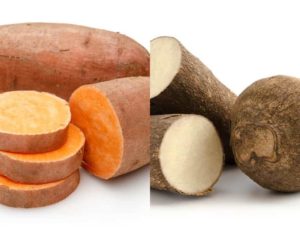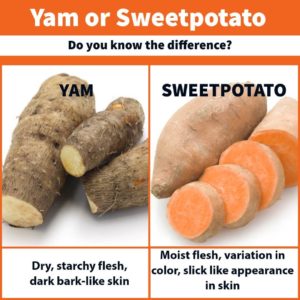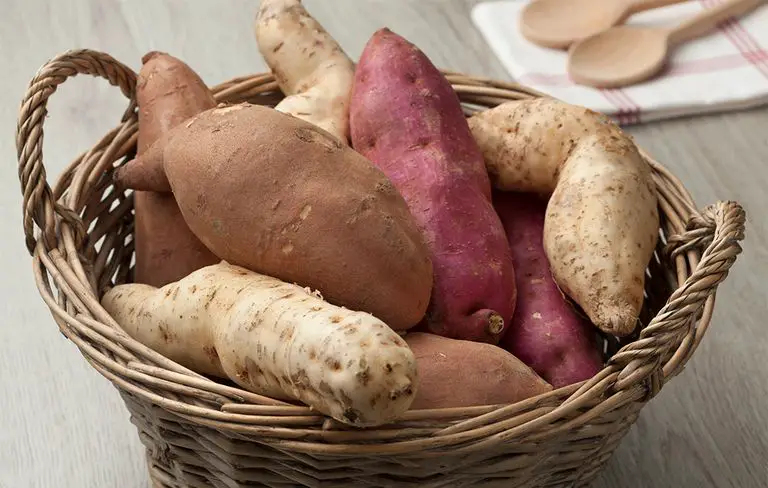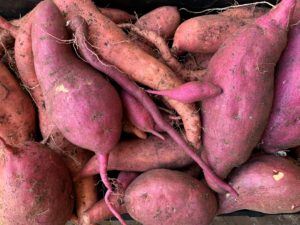Many people use the terms yam and sweet potato interchangeably. Although both grow as tubers, they are two different vegetables. So, what’s the difference?
Yams
Yams are members of the Dioscoreaceae family and are botanically unrelated to sweet potatoes. The cylindrical-shaped tubers have a dry, starchy flesh and a roughly textured, thick brown skin (although some may be pale pink) that makes it difficult to peel. The flesh is typically white to yellow, but some varieties have pink to purple flesh.
The 600 varieties of yams vary in size with some growing up to five feet (1.5 meters) or more in length and weighing upwards of 100 pounds (70kg). They are popular in Latin America, the Caribbean, Japan, the Philippines, Indonesia, Vietnam, and Africa with West Africa producing almost 95% of all yams grown worldwide.
If you live in the United States, good luck finding yams at your local grocery store. Most produce labeled “yams” are actually sweet potatoes. You will most likely have to go to a specialty market to find true yams but many claim it is worth the effort to buy this versatile and delicious tuber.

Sweet Potatoes
Sweet potatoes, on the other hand, belong to the Convolvulaceae family, as do morning glories. It is not surprising to find, therefore, that sweet potato blossoms closely resemble the trumpet-shaped flower.
The sweet tuber is known for its orange flesh; however, some varieties boast a white or yellow flesh while others a vibrant purple one. The thin skin likewise varies from the typical orange color to a white, purple, red, or garnet. Regardless of color, this root vegetable is sweeter and creamier than a yam.
Sweet potatoes masquerading as yams are most often associated with various candied casserole recipes at Thanksgiving, especially in the United States. But sweet potatoes are not native to the U.S., rather they are believed to have originated in Central America. Christopher Columbus reportedly encountered the sweet vegetable in 1492 on his first voyage to the Americas, taking the newfound produce back to Spain upon his return. From there, it spread to Europe and eventually migrated to North America in the area known as Virginia around 1650. More recently, North Carolina has become one of the top producers in the U.S., growing over 50% of the country’s sweet potatoes.

Sweet potatoes are not grown from “seed” potatoes as other potatoes are grown. Rather they are grown from “slips.” If you would like to know more about starting sweet potatoes from slips or how you can grow a bumper crop in beds or containers, check out these articles.
Why the Confusion Between Yams and Sweet Potatoes?
The confusion between these two vegetables began when men and women brought to America as enslaved people, began to associate sweet potatoes with the yams they had known in their native Africa. The confusion was then furthered by a Louisiana sweet potato trade group who, in the 1930s, began marketing their sweet potatoes as yams in an effort to distinguish them from sweet potatoes grown in other states.[1]
Cooking
Although yams and sweet potatoes are different root vegetables, they can be prepared in similar ways. Both are eaten boiled, roasted, and fried, and they are often used in soups, pies, casseroles, and even desserts.
Sweet potato flour, when combined with other grain-free flour, is becoming a popular substitute for those on a grain-free diet.

Nutrition
Both tubers are a good source of fiber, vitamins, and minerals. Although sweet potatoes provide more beta carotene, sugar, calcium, iron, protein, sodium, and vitamin A than do yams. On the other hand, yams, deliver more fiber, fat, potassium, carbohydrates, and vitamins C, B6, and E than do sweet potatoes.
At the next family gathering, you may still choose to refer to your grandmother’s sweet potato casserole as “candied yams,” but at least now you will be able to interject some fascinating facts while everyone is enjoying eating it!
Thank you for reading this article! If you found it helpful, please consider sharing it with others via email and social media!
[1] Margaret Eby, The Difference Between Yams and Sweet Potatoes is Structural Racism. Food & Wine, 02-06-20, accessed 06-04-22. https://www.foodandwine.com/vegetables/the-difference-between-yams-and-sweet-potatoes-is-structural-racism




